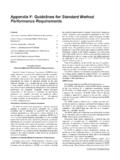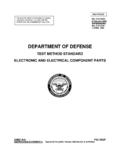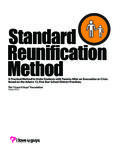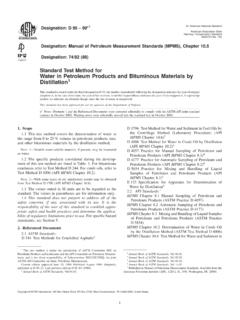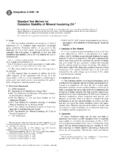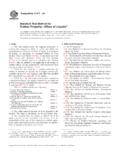Transcription of ANSWERS TO 26 KEY QUESTIONS ABOUT THE ANSI/BOMA …
1 Building Owners and Managers Association (BOMA) International 1101 15th Street, NW, Suite 800, Washington, DC 20005 Page 1 of 5 ANSWERS TO 26 KEY QUESTIONS ABOUT THE BOMA standard method OF MEASURING FLOOR AREA IN OFFICE BUILDINGS BOMA International is providing the following guidance on the standard method for Measuring Floor Area in Office Buildings, BOMA , for persons having QUESTIONS . This document is intended to clarify the intent and application of the Standard, but is not a part of the Standard itself. It is strongly recommended that this guidance be used with the Standard and not as a substitute for actually consulting the Standard. As Secretariat, BOMA is responsible for overseeing the committee that drafts the Standard and publishing the final document.
2 BOMA does not have on-staff technical expertise to respond to individual floor measurement inquiries. If a user of the document has a specific question in regards to the standard, BOMA provides a link to their floor measurement standard interpreters on If you have QUESTIONS relating to a situation not addressed directly by the available guidance, BOMA recommends that you follow an approach using best judgment derived from the guidance in print. 1. Q: Please explain the alternate method for calculating Rentable Area for each tenant referenced at the top of page 26. I am averaging the individual floor R/U ratios but the result doesn t equal the Building R/U Ratio.
3 A: The R/U ratio will usually differ for each floor, so that a building typically will not have just one R/U ratio. Since Floor Common Areas vary according to corridor configuration on the various floors, likewise the floor R/U ratio varies for each floor. The R/U ratio to be used on a floor is the product of the Floor R/U and the Building R/U (Floor R/U x Building R/U = R/U for that floor). Each floor of a building will have an R/U ratio by using this method. 2. Q: If a private stairway is built between two floors occupied by one tenant, is that stairway part of Rentable Area? Is it part of the Usable Area? A: Yes. The Standard states specifically that vertical penetrations built for the private use of a tenant occupying Office Areas on more than one floor are counted as Rentable.
4 The stairway would also be part of the Usable Area of the tenant. 3. Q: Are areas outside the fire resistance enclosure of a Major Vertical Penetration considered part of that penetration? For example, plumbing chases behind restrooms? A: Walls enclosing the major vertical penetration, which are required by building codes, are part of the penetration. Additional walls outside these enclosing walls are not considered part of the penetration and are not deducted from Rentable Area. Building Owners and Managers Association (BOMA) International 1101 15th Street, NW, Suite 800, Washington, DC 20005 Page 2 of 5 4. Q: How are enclosing walls defined in conjunction with Major Vertical Penetrations?
5 What ABOUT the floor of the stair tower or the elevator pits of the elevator shaft? A: The term enclosing walls refers to those walls required by building code, and not to the architectural or decorative treatments of those walls. The floor of a stair tower and the pits of the elevator shaft, when found inside the enclosing walls, are part of the Major Vertical Penetration. However, if an area is not within the enclosing walls (such as a storage room under the stair tower), the area is part of the Rentable Area. 5. Q: Regarding Dominant Portion .. where a wall meets a column (such as in the illustration on page 7), a bite appears to be taken out of the column as the measurement line shifts.
6 If the column is not square, how are the dimensions of the bite determined? A: Columns are not considered in the Standard. Therefore, where a column interrupts the Dominant Portion, the Dominant Portion that exists on each side of the column continues through one-half of the horizontal distance of the column. Where a column interrupts a Dominant Portion that is the same on both sides, the Dominant Portion continues through the column as if the column did not exist. Where a column interrupts a Dominant Portion that is different on each side, the Dominant Portion on one side continues for one-half the horizontal distance and then either steps in or out to meet the Dominant Portion from the other side.
7 6. Q: Are Major Vertical Penetrations included in Store Area? No -- Major Vertical Penetrations are excluded when calculating Store Area. Rentable Area itself excludes Major Vertical Penetrations -- and, since store area is less than or equal to Floor Rentable Area on the floor where the store is located, Store Area likewise will exclude Major Vertical Penetrations. 7. Q: Are areas of refuge (mainly a feature of Canadian buildings) deducted as Major Vertical Penetrations? A: If the area of refuge is not isolated from the stairwell, then it is part of the Major Vertical Penetration and deducted as such. If the area of refuge is isolated from the stairwell with its own set of doors, then it is part of Floor Rentable Area and distributed to each Office Area through the application of the R/U Ratio.
8 8. Q: If a Store Area is on a corner, is the measurement taken to the building line on both sides? Does it matter whether entrances to the space are located on both sides? A: Store Area requires a street frontage and a ground level. It is possible for a square building to meet these conditions on every one of its sides. In that situation and on that level, the Dominant Portion would be the building line on each side. However, the sides do not have to be at the same level. A building can have street frontage and ground level on one side ( , Floor 1) and street frontage and ground level ( , on Floor 3). Each of those two floors would be considered Store Area, and the Dominant Portion would be the building line.
9 Having a separate street entrance for the space is not a requirement in determining street frontage for a Store Area. 9. Q: How is building line defined where the ground floor building face is set back further than the upper floors from the street frontage? A: The Standard is intended to measure space that is fully enclosed. Therefore the building line, as used in the Standard to determine Store Area, is the outside face of the column line (or the exterior building surface if columns are not present) of the ground floor on the street frontage exposure. Deviations to the building line, including projections or recesses, are ignored unless they are part of the permanent building exterior of the ground floor.
10 Building Owners and Managers Association (BOMA) International 1101 15th Street, NW, Suite 800, Washington, DC 20005 Page 3 of 5 10. Q: Is a courtyard included in Building Common Area if it is enclosed by four sides but not a roof? (See reference to fully enclosed courtyard outside the exterior walls at top of page 3 of the Standard and illustration on page 19.) A: Fully enclosed refers to an enclosed space where environmental conditions are maintained by a heating, ventilating and air conditioning system. So there must be a roof in order for the courtyard to be fully enclosed. 11. Q: On an above-ground floor, can a corridor that is ordinarily Floor Common Area be assessed to a particular tenant if it provides the only access to their space?
